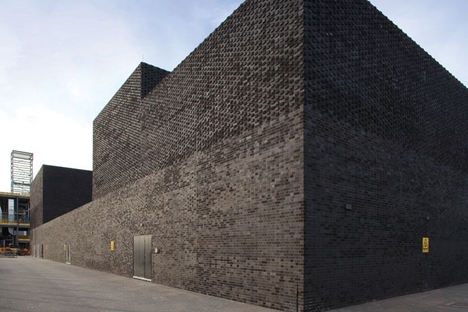
It’s a bit of a truism that most architects of a certain age have a bit of pastiche pomo in their closet, and in a way this often makes the appreciation of their other works a bit suspect. Take Jim Stirling as an example here. The fact that he ended up making No.1 Poultry retroactively puts a bad taste in your mouth when you’re marvelling at the ridiculously refined staircase details of the Florey building in Oxford. The point here is that you often realise that an architect was only ever following orders, despite how much virtuosity they might have followed them with. If there is a project to reinvigorate the polemic power that was a part of modernism, we have to accept that there are always those who do what they’re told no matter who’s telling them.
Now, regarding closeted skeletons, it has to be said that postmodernism is - to make a ridiculously ironic understatement - something that the French have always done well. I recently pointed out a pomo-bridge design by Francois Soler, an extreme example of the latent expressionism of engineering structures, a sort of hybrid pomo-tech. Jean Nouvel also had a habit of designing buildings in this manner, his Institute du Monde Arabe with its photovoltaic mashrabiya screen being a good example. But I found a really interesting little skeleton in his closet from 1984; a deconstructivist skeleton, no less.

I think decon suffered greatly from the interference of Philip Johnson, a recurring theme in the 20th century. Compared with his aestheticisation of the ‘International Style’, what happened to decon after it was passed through his hands was not a depoliticisation, but rather a de-intellectualisation (although – decon architecture’s intellectual credentials are never entirely credible). Dumbing it down into issues of shape is less of a hatchet job of course, but it’s still a disservice which led easily into wanton formalism and very much assisted in decon’s eventual metamorphosis into the ‘iconic’ building.
Decon as a method was always far more interesting and successful when it had to deal with a rich site; Eisenman’s excavatory projects are more interesting than his pure-formalist projects for example, and Bernard Tschumi had some great ideas that were only ruined by them having to have been built in the 1980s. Nouvel’s Belfort Theatre, completed in 1984, would appear to be a good example of decon in its more challenging and satisfying variant.

Effectively a renovation/extension, the theatre contains some stock decon tropes; Nouvel plays two local geometries off of each other, setting architectural features at seemingly strange angles from the volume of which they are elements. A grid of lightweight structure is added to one façade, running through the windows and off at the ends. Certain aspects of the previous buildings are retained in various ways inamongst the new structure, creating a collage effect that the best decon sought to achieve. There are other features that Nouvel uses here though that I’ve not seen anywhere else. He had workmen go at some of the previously badly renovated facades with a jack-hammer, creating patterns with the revealed brickwork underneath them. He even went so far - and this is where decon spoils itself by becoming an architectural parlour game – as to have ‘hatching’ hammered into walls that appear to have been truncated, and to have the profile of the concrete floor projecting beyond the walls. These mannerist in-jokes combine with the grid try to make the building into a technical section drawing of itself. Other over the top aspects are the half windows onto nothing, and it must be said that there are some typically embarrassing bits of 80s detailing here and there. But overall it’s an interesting building, thankfully without the floating trapezoidal forms or wonky pilotis that would be the only things that decon qua architectural method would carry forward to the 90s and beyond.

But this saturated-site approach didn’t necessarily disappear. Some of the work of EMBT, for example, was capable of creating resonant juxtapositions of old, new and quasi-old elements, with an attitude that while not necessarily theoretical, was intelligent and self assured, and which had a great sense of ‘specialness’ and bricolage, like a series of posters that have slowly and unevenly been worn away. Their work leaves the more esoteric aspects of decon behind while still being rich with reference to architectural history, both of the contextual and canonical sort.
I think that overall it’s worth noting that there were aspects of the ‘pomo’ project that were serious attempts to create a synthesis of modernism and historically embedded architecture, that at the very least attempted to address the difficulty of creating buildings within an archive of built statements.















